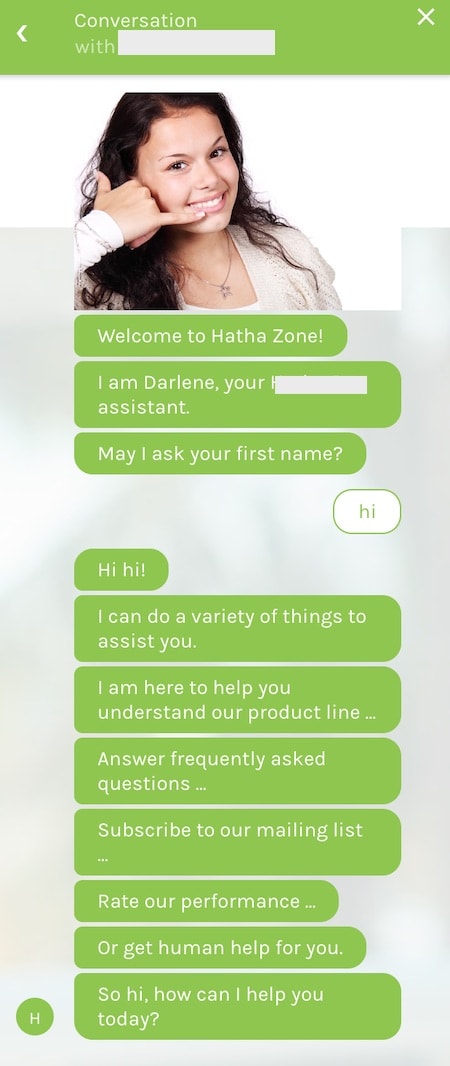Shopify Chatbots: A Guide to Scaling Online Sales

Shopify is an incredible ecommerce platform. They are massive (£900M expected revenue in 2018) for many reasons, least of which being how easy it is to get set up.
Huge businesses are built through Shopify. It is no surprise Shopify chatbot solutions are starting to become a thing. Back in 2016, Brandon Chu (Shopify's senior product manager) announced their first integration with Facebook Messenger.
"Messaging apps are enabling us to rekindle the conversations we are used to having in person with retail businesses, and recapture some of the lost intimacy that comes with shopping online.Our decision to integrate with Messenger and build commerce bots, is designed to help merchants develop deeper relationships with their customers, and give them an opportunity to reinforce their brand’s personality."
(source)
Today, a quick search on Shopify's app store returns chatbot solutions.

In this article, I'm going to give you an overview of these solutions as well as real, practical advice on how to increase your revenue with Shopify chatbots.
Lots to cover!
What is Shopify (in 50 words)
Shopify is an online commerce platform. It is completely cloud-based, which has made it incredibly easy for a wide variety of people to set up and start selling online.
Shopify by the numbers:
- 600,000 online stores (May 2018)
- Over 1M active users (April 2017)
- $55Bn in total sates to date (May 2018)
Damn it, seven words too long...
Chatbots and ecommerce
If any industry chatbot technology was due to take by storm, it is ecommerce.
Chatbots offer one-to-one conversations at scale, between a human user (for now) on one side and a machine (the business) on the other side. They offer instant gratification to the user looking for something, anything.
They are artificial intelligent software programmed to be there 24/7, helping and answering questions.
In the ecommerce world, this, of course, brings a world of potential.

In simple terms, a chatbot is a machine present on your website or your social media platform that is programmed to interact with customers in a conversational way.
They offer a win-win situation.
To the retail customer
Having access to a chatbot is an instant help.
Instead of having to trawl through a clunky website, guess which product would fit your requirement, painfully read through descriptions to find the key information you are looking for -- instead of all this, you get to ask questions.
Plain and simple.
And, you get an answer 24/7 because chatbots don't sleep.
To the retail business
Integrating a chatbot to your ecommerce store means safety in the knowledge that your store visitors will always have something answering their questions.
No more 'open hours'. No more struggling to answer questions within 1-2 days. No worrying over the potentially exorbitant cost of hiring human help.
Oh, and most decent chatbots also cross-sell products as they talk to users. So, double-win for the retail side.

The statistics around chatbots and ecommerce don't lie
- 83% of online shoppers need help when shopping (Liveperson)
- 71% of consumers use chatbots to solve their problems, fast (HubSpot)
- Consumers are willing to spend over £300 through a chatbot (ubisend)
These are just some of the statistics that explain why I am even writing a piece on integrating chatbots into a Shopify store.
It is clear chatbots are the future of ecommerce.
Planning your Shopify chatbot
Before we move on to implementing, it is always worth doing a little bit of prep. Below is a shortened version of a more in-depth article I wrote a little while ago.
In this very specific case, though, I would advise you ask yourself these three questions.
1. What is the purpose of your chatbot?
So far, this article has mostly been about the upside of having a chatbot that increases revenue. From an ecommerce point of view, it makes a lot of sense.
Of course, this isn't the only thing a chatbot is capable of doing -- even on your online store. Your chatbot could be aimed at customer support, answering questions about your products, shipping, returns, etc. Or, your chatbot could be aimed at marketing, collecting email addresses, hyping newer products and next releases.
Pick one.
From our experience, it is best to pick one goal for your chatbot (what we call its One True Goal).
What is your chatbot's purpose? Why are you implementing it on your Shopify platform?
2. Pick a metric and a target
Once you know why you're implementing a chatbot, it's time to pick a metric. It's usually quite easy to find out which metric should tie to your chatbot's goal.
If you can't figure it out for yourself, ask a friendly marketer for help.
Examples:
- A sales chatbot's metric: number of sales attributed to the chatbot (e.g. over 500 autonomous sales).
- A customer support chatbot's metric: number of tickets answered properly by the chatbot.
Keep your user (the customer) in mind. They are on your Shopify store for a reason and interacting with your chatbot for a purpose. What does a successful interaction look like for them?
3. Prototype it
I can't stress this enough. Start small.
I spend my time talking about conversational software with some of the largest brands in the world. Guess what I tell them? Prototype it.
You want to keep your chatbot simple at first. This means starting with a simple goal, a simple metric, and a simple implementation. Once you see it works, you can start investing more and expanding your chatbot's horizons.
In the next section, I will talk through implementing out-of-the-box Shopify chatbots through their app store and custom solutions through professional companies like ourselves.
Because I believe in prototyping so much, I don't mind sharing information on how to implement a free Shopify chatbot first. In fact, our best clients went free first. It is the best way to test the waters and figure out what works before tripling down (and coming to talk to us).
Key takeaway
Before you start building your chatbot, decide on
- Its purpose
- Metrics
- A prototype approach
Implementing a Shopify chatbot
There are two ways you can implement a chatbot to your Shopify website.
Like I've mentioned above, I believe there is merit in both and therefore will cover both in this article.
1. Out-of-the-box Shopify chatbot solution
Shopify is far from just an ecommerce platform. Over the years, they have done an amazing job at creating an entire marketplace of useful apps.

Shop owners can browse through this marketplace to download and activate these apps on their online store. It's no surprise you will find some out-of-the-box chatbot solutions on Shopify's marketplace.
Pros of using an out-of-the-box Shopify chatbot
- Easy to set up (<10min).
- Cheap or even free
- Great for a prototype
While I won't recommend any, the process to set up an out-of-the-box Shopify chatbot is simple (and similar across most of them).
- Search for them on the app store
- (Optional) pay for the solution of your choice
- Activate the solution in your store
Step 3 is the one that is going to vary depending on the solution you end up picking. Some out-of-the-box Shopify chatbots offer more tools than others, which will require some setting up.
Cons of using an out-of-the-box Shopify chatbot
- Most likely flow chatbot
- Close to zero customisability
- Very limited functionalities
- Poor NLP (if any)
Flow chatbots are chatbots that rely on the user clicking buttons and using keywords to move the conversation forward. Flow chatbots don't rely on language, can't hold a normal conversation.
While, again, flow chatbots have their place in the market, they are extremely limited and frankly quite dull. If you recall, the whole purpose of implementing a chatbot on an ecommerce solution is to bring personalisation and 1-1 conversations to the users at scale.
Presenting them with a set flow of buttons is contradictory to that.

The image above shows you one of these bots in action. It doesn't respond to any normal user input. It only responds to trigger words ('exclusive promotions'). It also only seems to respond with links. There is no dialogue there.
Some experiences are even worse, like the one below that literally blasted me with messages in 0.5sec after I said hi.

Key takeaway
Out-of-the-box Shopify chatbots can be great to test the waters but they are very limited. Go through a few of them, play with the options and see if a chatbot is something you want. Don't expect to go the distance with them, though.
2. Custom Shopify chatbot solutions
The obvious next step: going custom.
There is only so much you can do with a templated solution that needs to work for a wide range of businesses. Unfortunately, as we've seen above, even that 'so much' is in actual fact very little.
We are quite lucky in that Shopify have a fairly extended API, allowing high-end chatbot developers like ubisend to build cool custom stuff!
Pros of a custom Shopify chatbot solution
- Built to your specific requirements
- Custom tracking and dashboards
- Evolves with you
- As complex as you need it to be
- Unleashes the power of artificial intelligence
- Business intelligence
- End-to-end integrations
Once you've outgrown the templated approach, you go custom. You do so to get a solution that does exactly what you want it to do -- nothing more nothing less.
With a custom chatbot, you can do just that.
The most common reason clients come to us for a custom Shopify implementation is to turn their current solution into an end-to-end product.
We can build anything our clients want, and most of the time that means pulling data from somewhere and pushing it somewhere else -- with a customer interaction in the middle.
Tailored dashboards are also very popular.

When you run a million pound business through Shopify and you implement a chatbot, you are looking to gather specific business insights from its conversations. What can you learn from them? How can you improve it to increase revenue?
Cons of a custom Shopify chatbot solution
- More expensive than out-of-the-box solutions
- Requires more planning
While most out-of-the-box solutions are cheap or even sometimes free, a custom chatbot solution will have a cost. Thankfully, in the world of ecommerce, everything is quantifiable. You can easily match up the cost of the solution with the upside it will bring (in terms of up-sells, cross-sells or even support ticket reduction) and do the math.
In my experience, if as a Shopify store owner you are asking yourself whether or not you should move on from the out-of-the-box solution, the math will come out in favour of the custom implementation.
Finally, as with any custom chatbot, more planning work will be required. We're not in the '10min set up' territory anymore. We are now talking about third-party integrations, connecting databases, custom APIs, bespoke conversational UX, and more.
All worth it for the enhanced experience and extra revenue.
Key takeaway
A custom solution is always going to be more costly than a one-size-fits-all mass market tool. However, it is also the obvious next step to unlock greater revenue and better fit your business growth.
Final thoughts
We are at a golden age. Chatbot technology advanced enough in the last couple of years to provide stable solutions humans actually like to use (i.e. beyond the flow chatbot debacle).
Coupling them with incredible platforms like Shopify is a sure fire way to increase revenue.












